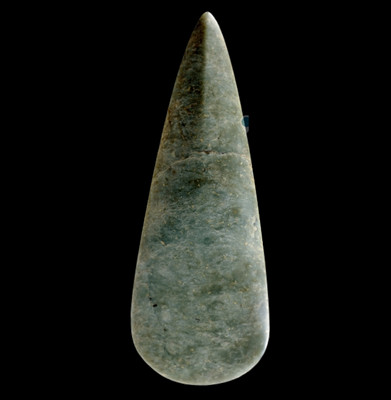Axes like this normally have a haft-that is, they're fitted into a long wooden handle and they're used like a modern axe; but it's quite clear that our axe has never been hafted-in fact, it shows no signs of wear and tear at all. If I run my finger carefully, rather gingerly, round the blade end, I can't feel even the smallest chip. The long flat surfaces are remarkably smooth and still have a glossy, mirror-like sheen.
斧頭通常都有斧柄,裝上長(zhǎng)長(zhǎng)的木制斧柄,才能像現(xiàn)代斧頭一樣發(fā) 揮功用。但很明顯,本節(jié)中的這把斧頭從未裝過斧柄,且完全沒有任何使用過的痕跡。用手指小心地?fù)崦校餐耆杏X不到哪怕最細(xì)微的缺損。長(zhǎng)而平坦的表面極為光滑,仍舊發(fā)出鏡面般的光澤。
The conclusion is obvious: not only has our axe not been used-it was never intended to be used. Mark Edmonds of York University explains how this magnificent prestige object was made:
結(jié)論是肯定的。這把斧頭從未被使用過,人們打造它的目的也不是使用,而是欣賞。約克大學(xué)的馬克埃德蒙玆闡述了這件華麗迷人的物品是如何打造出來的:
"If you have the good fortune to handle one of these axes-the feel in the hand, the balance, the weight, the smoothness-they have been polished to an extraordinary degree. We are talking about hour upon hour of grinding against stone, and then polishing with fine sand or silt and water, and then rubbing backwards and forwards in the hand, perhaps with grease and leaves, to really give that polish-that's days and days of work. It gives the edge a really sharp and resilient bite to it, but the polishing also brings out the shape, allows the control of form, and brings out that extraordinary green and black speckled quality to the stone-it makes it instantly recognisable, it makes it visually very striking. And those things maybe are just as important almost as the cutting edge."
如果你有幸握過一把這樣的斧頭,感受它的重量、光滑與均衡, 就會(huì)了解工匠們將其打磨得何等精細(xì)。要獲得這樣的光澤,先要用石頭長(zhǎng)時(shí)間打磨,再用細(xì)沙或混水的泥沙拋光,最后在手里反復(fù)摩挲,可能還要用上油脂和樹葉。不知道要用掉多少天的工夫才能磨 出尖端略帶彈性的利刃。在打磨的過程中還要留心形狀,控制形式,體現(xiàn)出這種玉石特有的黑綠相間的色澤,讓它變得十分搶眼,使人 一眼就能認(rèn)出。對(duì)這樣的斧頭來說,視覺事受也許與鋒利的斧刃同樣重要。












